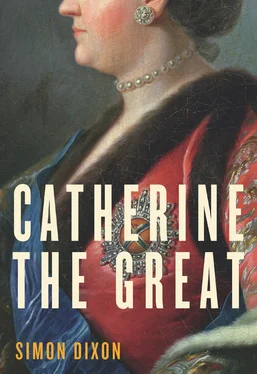However uncertain she may have been about her future, Sophie was acutely conscious of how much she was leaving behind, subsequently portraying her journey to Russia in terms of sacrifice rather than opportunity. By convention, Christian August was not invited, though he accompanied his daughter to Berlin, where Frederick looked her over while instructing her mother about her conduct in St Petersburg. Though few of her contemporaries were to play such an important part in Sophie’s life, she never saw the king again. She caught her last glimpse of her father at a tearful parting at Schwedt an der Oder on 17 January, the day after leaving Berlin. ‘The separation was as sad as one could possibly imagine,’ she remembered in 1756. 65
After that, she faced an uncomfortable trek across the wastes of Pomerania and East Prussia, so bereft of snow that winter that the journey had to be made in carriages rather than sleighs. Peering through narrow eye-slits in the woolly hats that protected their faces, they left Stargardt (now Szczecinski) in icy conditions on 18 January. From there, it was a tortuous progress eastwards through Keslin, skirting Danzig, and over the Vistula to Marienwerder. 66Although Frederick William I had already attempted to drain the Oder Marshes in the 1730s with the help of Dutch hydraulic engineers, the epic work of transforming the watery landscape east of the Oder still lay in the future in 1744. Over the next thirty years, it would be the king’s son, Frederick the Great, and his colonists who transformed the valleys of the Elbe, the Oder, the Warthe, the Netze and the Vistula into productive agricultural land. (‘Making domain lands cultivable interests me more than murdering people,’ Frederick remarked in a characteristic jibe against his brutal father.) 67At the time of Sophie’s departure for Russia, the whole area remained a patchwork quilt of stagnant pools and marsh, punctuated by areas of thick, waterlogged brush—an unregulated paradise for outlaws and bandits, offensive in itself to the standardising instincts of Frederick’s Enlightened administration. Like much of the rest of Europe, such a landscape was barely passable in spring and autumn, when flooding washed away the tracks that snaked across the marshes. In winter, it was a perilous wilderness. Sophie and her mother avoided the worst dangers by keeping close to the coast. ‘Our journey was long, very boring, and very painful,’ she later remembered of their odyssey between primitive roadside inns. ‘My feet were so swollen that I had to be lifted in and out of the carriage.’ 68
During a rare day of rest at Königsberg, where another product of Pietism, the philosopher Immanuel Kant, was already a twenty-year-old student at the university, Sophie wrote to her father (in French). Mindful of the instructions he had signed at Zerbst on 3 January that no one must persuade her to renege on her religious beliefs, she adopted her most dutiful tone:
Monseigneur,
I have received with all imaginable respect and joy the letter in which Your Highness does me the honour of reassuring me about his health, about his remembrance of me, and his good wishes. I beg to reassure him that his exhortations and his counsel will remain eternally engraved in my heart, just as the seeds of our holy religion will be in my soul, for which I ask God to lend all the strength that I shall require to resist the temptations to which I am preparing to expose myself. 69
Before she faced those temptations, however, there was still almost two-thirds of the journey to go. Passing north-eastwards into Courland—‘at all times a desert country’, as a British diplomat had been warned by the canny purveyors of Königsberg four years earlier—she saw the ‘terrible’ comet first observed from Sweden and the Netherlands at the end of November 1743. 70At its brightest in the following March, it displayed as many as twelve fanning rays in the manner of a peacock’s tail. ‘I have never seen a bigger one,’ the mature empress declared; ‘it seemed very near to the earth.’ 71She was not alone in her fascination. Though clouds obscured the comet from much of the continent until the New Year, news of it spread rapidly in the European press. ‘The Comet this Evening appeared exceeding bright and distinct,’ recorded an Oxford astronomer on 23 January, ‘and the Diameter of its Nucleus nearly equal to that of Jupiter’s; its Tail, extending above 16 Degrees from its Body, pointed towards Andromeda; and was in Length (supposing the Sun’s Parallax 10″) above 23 Millions of Miles; but cloudy Weather succeeding, we lost this agreeable Sight till Feb. 5th.’ 72That must have been roughly when Sophie saw it. Since comets had until recently been regarded as portents of disaster, she might have been forgiven for wondering what such an apparition beheld for her in a distant foreign land. 73But she would mock Empress Elizabeth for holding such superstitious views in 1756, when popular scientific accounts of comets were about to appear in Russian journals. 74And twenty-one years after her experiences on her journey to St Petersburg, Grigory Orlov, a keen amateur astronomer, would read aloud from one such treatise while Catherine amused the rest of the company by fantasising about what might happen if a comet carried them away and turned them all to glass. 75
It was a very different Russian nobleman who met Princess Sophie just beyond Mitau (now Jelgava in Latvia) and guided her over the frozen River Dvina into the Russian empire. Johanna Elisabeth and her daughter had first encountered the thirty-three-year-old Semën Naryshkin in Hamburg on his return from London. As a youthful ambassador to the Court of St James, he had gained ample practice in the diplomatic niceties that would serve him well as a future Marshal of Elizabeth’s Court. Now Master of the Hunt, no one was better equipped than this most flamboyant of courtiers to flatter Sophie’s mother, who assumed he must be a prince and exposed her delusions of grandeur with a gushing travel account that placed her at the centre of events. Since it had proved impossible to heat the imperial apartments at Riga, where they gained eleven days by reverting to the Julian calendar, she and Sophie were given tastefully furnished rooms at the house of a wealthy merchant, not unlike the one in which her daughter had been born. In every other respect, theirs was a royal progress, intended to overwhelm them with a sense of Russia’s imperial power and prestige as they drove through crowded streets to fanfares of trumpets and drums. ‘It feels as though I am part of the entourage of Her Imperial Majesty or some great princess,’ wrote the disingenuous Johanna Elisabeth: ‘It never enters my head that all this is for poor me.’ 76
Until they entered Russian territory, Sophie’s mother had been travelling incognito as Countess Rheinbeck, accompanied by only the most modest of suites: her chamberlain, her lady-in-waiting, four chambermaids, a valet, a handful of lackeys and a cook. Now, wrapped in the priceless sables presented to them by Naryshkin, they continued their journey under cavalry escort in long imperial sleighs drawn by ten horses. As Catherine later recalled, it was quite an art even to climb into these elaborate vehicles, in which passengers lay recumbent on bulky feather mattresses, lined with silk and covered with satin cushions. 77Still, there was little enough to see as they traversed a snowy landscape razed by the Russians in the first decade of the century when it seemed that the invading Swedish army might triumph in the Great Northern War. Not until the 1770s did Russia’s Baltic provinces recover their pre-war population levels after a campaign in which as many as 70 per cent of the population of Livland and Estland may have perished. At Dorpat (now Tartu in Estonia), which the Russians had taken from the Swedes in 1704, the signs of the bombardment were still visible. 78Their final calling point was Narva, where 11,000 Swedish troops had humiliated Peter the Great’s 40,000-strong army in November 1700, prompting far-reaching military reforms that helped to underpin tsarist imperial expansion for the remainder of the century. From there, it was a relatively short distance along the southern shores of the gulf of Finland to the Russian capital, where they arrived on the afternoon of 3 February towards the end of the carnival season.
Читать дальше












